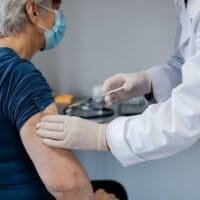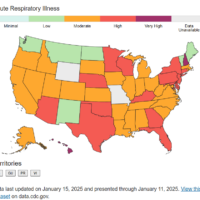On Aug. 31, 2022, the Food and Drug Administration authorized the use of updated COVID-19 booster shots that are specifically tailored to combat the two most recent and contagious omicron subvariants, BA.4 and BA.5. Following the FDA’s emergency use authorization, the Centers for Disease Control and Prevention is expected to endorse the shots, allowing them to be administered within days.
The new booster shots – one by Moderna and another from Pfizer-BioNTech – come as more than 450 people are still dying of COVID-19 every day in the U.S.
As of Aug. 31, 2022, only 48.5% of booster-eligible people in the U.S. have received their first booster shot, and just under 34% of those eligible have received their second. These low numbers may in part be influenced by people waiting for the newer versions of the vaccines to provide better protection. But booster shots have proven to be an essential layer of protection against COVID-19.
Prakash Nagarkatti and Mitzi Nagarkatti are immunologists who study infectious disorders and how vaccines trigger different aspects of the immune system to fight infection. They weigh in on how the updated booster shots train the immune system and how protective they might be against COVID-19.
1. What is different about the updated booster shots?
The newly authorized shots are the first updates to the original COVID-19 vaccines that were introduced in late 2020. They use the same mRNA technology as the original vaccines. The key difference between the original COVID-19 shots and the new “bivalent” version is that the latter consists of a mixture of mRNA that encodes the spike proteins of both the original SARS-CoV-2 virus and the more recent omicron subvariants, BA.4 and BA.5.
As of late August 2022, the BA.4 and BA.5 omicron subvariants are dominant worldwide. In the U.S., currently 89% of COVID-19 infections are caused by BA.5 and 11% are caused by BA.4.
The inability of the original vaccine strains to prevent reinfection and to trigger long-term protective immunity prompted the need for the reformulated vaccines. https://www.youtube.com/embed/vZeTs9-rgPU?wmode=transparent&start=0 The booster shots target the BA.4 and BA.5 subvariants of the omicron variant, as well as the original version of SARS-CoV-2, the virus that causes COVID-19.
2. How does a bivalent vaccine trigger an immune response?
In an actual COVID-19 infection, the SARS-CoV-2 virus uses its protruding spike protein to latch onto human cells and gain entry into cells. The spike protein triggers the production of so-called neutralizing antibodies, which bind to the spike protein and prevent the virus from invading other cells.
But when the virus mutates, as we know that it does, the antibodies that were previously produced in response to the virus can no longer effectively bind to the newly mutated spike protein. In this respect, the SARS-CoV-2 virus acts like a chameleon – a master of disguise – by changing its body configuration and escaping recognition by the immune system.
The ongoing viral mutations are why antibodies produced in response to the original vaccine strains have over time become less effective at fending off infections by new variants.
The concept of bivalent vaccines aimed at protecting against two different strains of a virus is not new. For instance, Cervarix is an FDA-approved bivalent vaccine that provides protection against two different types of human papillomaviruses that cause cancer.
3. How protective will the new shots be against infection?
There are as of yet no human studies on the efficacy of the new bivalent vaccine at preventing reinfections and providing long-term immune protection.
However, in human clinical trials and laboratory studies, both Pfizer-BioNTech and Moderna found that their initial version of the bivalent vaccine, which was directed against the original SARS-CoV-2 virus and an earlier omicron strain, BA.1, induced a strong immune response and longer protection against both the original strain and the BA.1 variant. In addition, the companies reported that the same early combination generated a significant antibody response against the newest omicron subvariants, BA.4 and BA.5, though this antibody response was lower than that seen against subvariant BA.1.
Based on those results, in spring 2022 the FDA rejected the BA.1 bivalent boosters because the agency felt the boosters may fall short of providing sufficient protection against the newest strains, BA.4 and BA.5, which were by then spreading quickly throughout the U.S. and the world. So the FDA asked Pfizer-BioNTech and Moderna to develop bivalent vaccines specifically targeting BA.4 and BA.5, instead of BA.1.
Because clinical trials are time-consuming, the FDA was willing to consider animal studies and other laboratory findings, such as the ability of antibodies to neutralize the virus, to decide whether to authorize the bivalent boosters.
This decision has stirred up controversy over whether it is appropriate for the FDA to approve a booster without direct human data to support it. However, the FDA has stated that millions of people have safely received the mRNA vaccines – which were originally tested in humans – and that the changes in the mRNA sequences in the vaccines do not affect vaccine safety. Thus, it concluded that the bivalent vaccines are safe and that there is no need to wait for human clinical trials.
It is also noteworthy that influenza vaccines are introduced each year based on prediction of the strain that is likely to be dominant, and such formulations do not undergo new clinical trials.
Based on available evidence from the previous COVID-19 vaccines, we believe it is very likely that the new boosters will continue to offer strong protection from severe COVID-19 leading to hospitalization and death. But whether they will protect against reinfection and breakthrough infections remains to be seen.
4. Will it only be a booster shot?
The bivalent vaccines can only be used as a booster shot at least two months after the completion of the primary series – or initial required shots – or following a previous booster shot. The Moderna bivalent vaccine is authorized for use in people 18 years of age, while the Pfizer bivalent vaccine is authorized for those 12 years of age and older.
Because of the superiority of the bivalent vaccines, the FDA has also removed the use authorization for the original monovalent Moderna and Pfizer COVID-19 vaccines for booster purposes in individuals 18 years of age and older and 12 years of age and older, respectively.
The new bivalent vaccines contain a lower dose of mRNA, and as such are meant to be used only as boosters and not in people who have never received a COVID-19 vaccination.
5. Will the new shots protect against future variants?
How well the bivalent vaccines will perform in the face of new variants that might arise will depend on the nature of future spike protein mutations.
If it is a minor mutation or set of mutations when compared to the original strain or to omicron variants BA.4 and BA.5, the new shots will provide good protection. However, if a hypothetical new strain were to possess highly unique mutations in its spike protein, then it’s likely that it could once again dodge immune protection.
On the flip side, the successful development of the updated vaccines demonstrates that the mRNA vaccine technology is nimble and innovative enough that – within a couple of months of the emergence of a new variant – it is now likely possible to develop and distribute new vaccines that are tailor-made to fight an emerging variant.
This article is republished from The Conversation under a Creative Commons license. Read the original article.
Dr. Mitzi Nagarkatti is SmartState Endowed Chair of Center for Cancer Drug Discovery as well as Carolina Distinguished Professor and Chair of the Dept. of Pathology, Microbiology and Immunology at the School of Medicine (SOM), University of South Carolina (UofSC). In 2005, Dr. Nagarkatti moved from the Medical College of Virginia where she was a Professor in the Dept. of Microbiology and Immunology as well as directed the Immune Mechanisms Program of the National Cancer Institute (NCI)-designated Massey Cancer Center.
Dr. Nagarkatti’s research is broad-based and encompasses Inflammation, Autoimmunity, Complementary and Alternative Medicine, Cancer Immunology and Immunotherapy, and Immunotoxicology. Dr. Nagarkatti has been the recipient of >$70million in extramural funding as Principal Investigator (P.I.)/Co-P.I. to support the research in her lab since moving to UofSC. She is currently theP.I./on 3 National Institutes of Health (NIH) R01 grants. She also serves as the Co-P.I. of yet another Center Grant for $6million from National Center for Complementary and Integrative Health (NCCIH) to study the epigenetic mechanisms underlying the role of plant products in treatment of inflammatory and autoimmune diseases, which was renewed for an additional 5 years for $8million. In addition, Dr. Nagarkatti is also a Co-P.I. on a 5-year COBRE grant on Dietary Supplements and Inflammation for $10million which was a renewal of a previous 5-year grant for $10million, aimed at recruiting and mentoring junior faculty. Dr. Nagarkatti’s research has been continuously funded by agencies including the NIH, VA, US Army, American Cancer Society, NSF/EPA as well as other private foundations.
Dr. Nagarkatti is an American Association for Advancement of Sciences (AAAS) Fellow as well as Fellow of the Academy of Toxicological Sciences. Dr. Nagarkatti was appointed to the prestigious National Toxicology Program (NTP) Board of Scientific Counselors. Dr. Nagarkatti has been the recipient of numerous awards such as the Pfizer Award, UofSC Breakthrough Leadership Award, Diversity and Inclusion Leadership Award, etc. Dr. Nagarkatti has trained several undergraduate, graduate, medical and veterinary students, postdoctoral fellows and junior faculty. She has published ~300 scientific papers in high-impact journals and presented ~450 research abstracts at international, national and regional meetings. She has been an invited speaker and has chaired scientific sessions at national and international meetings. Dr. Nagarkatti has served as a reviewer for grant proposals for funding agencies such as National Institutes of Health (NIH), American Cancer Society (ACS), Dept. of Defense (DOD), etc. She is currently a regular member of NIH SIEE Study Section.






